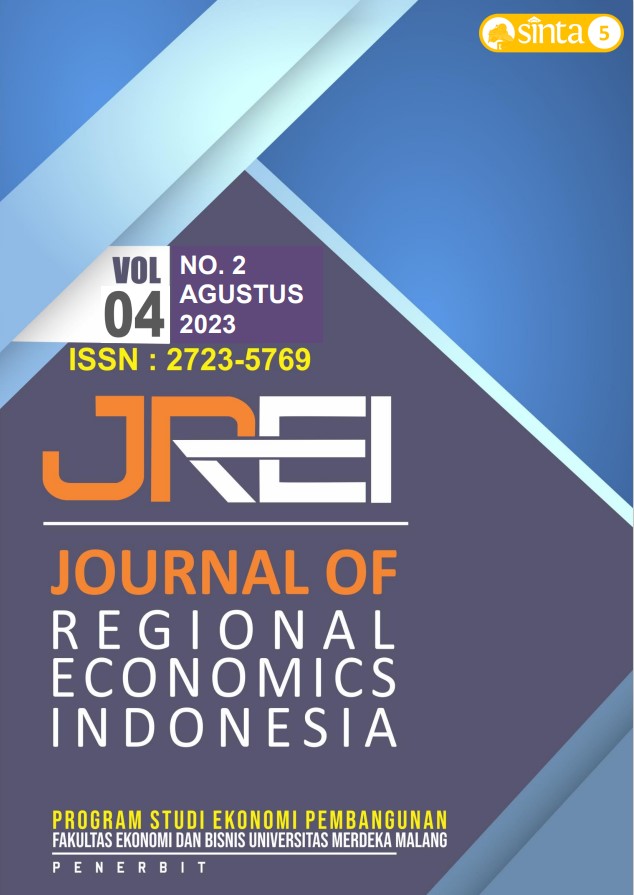Kualitas Perencanaan Sektoral dan Perencanaan Wilayah Terhadap Kinerja Perekonomian Daerah (Studi Kasus Provinsi Gorontalo)
DOI:
https://doi.org/10.26905/jrei.v4i2.12341Abstract
Sasaran jangka panjang pembangunan adalah ingin mencapai masyarakat yang sejahtera adil dan makmur. Sasaran ini diwujudkan melalui tahapan pembangunan jangka pendek dengan sasaran pertumbuhan ekonomi meningkat dan stabil, terciptanya kesempatan kerja, penurunan kemiskinan dan terdapatnya distribusi pendapatan yang semakin meningkat. Tulisan ini ingin mengupas dampak perencanaan pembangunan sektoral terhadap capaian pertumbuhan ekonomi, kemiskinan dan distribusi pendapatan dengan mengambil kasus di Provinsi Gorontalo. Hal ini didukung dengan pandangan yang mengulas beberapa kelemahan perencanaan sektoral dan juga mengkaji alternatif perencanaan berbasis wilayah. Pendekatan kajian adalah literature review dengan menampilkan data capaian kinerja pembangunan berbasis perencanaan sektoral. Hasil pembahasan mengindikasikan bahwa perencanaan sektoral tidak sepenuhnya mampu menyelesaikan masalah pembangunan, terutama bagi pengentasan kemiskinan dan capaian distribusi pendapatan. Tulisan ini mengusulkan urgensi bagi pemerintah untuk mengkombinasikan antara perencanaan sektoral dengan perencanaan wilayah dengan cara memperbanyak kutub pertumbuhan yang membentuk hexagonal pusat pertumbuhan.Downloads
References
Addison, T., Niñoâ€Zarazúa, M., & Pirttilä, J. 2018. Fiscal policy, state
building and economic development. Journal of International
Development, Vol. 30, No. 2, pp. 161–172.
Albegov, M., & Granberg, A. 1989. Regional and multiregional modelling
in the U. S. S. R. Papers of the Regional Science Association, Vol. 66, No. 1, pp. 77–86.
Backhouse, R. E., & Medema, S. G. 2008. Laissez-faire, Economists and. In The New Palgrave Dictionary of Economics, pp. 1–12. Palgrave
Macmillan UK.
Cantore, C., & Freund, L. B. 2021. Workers, capitalists, and the
government: fiscal policy and income (re)distribution. Journal of
Monetary Economics, Vol. 119, pp. 58–74.
Chenery, H., & Clark, P. 1962. Interindustry Economics. Wiley.
Christaller, W. 1933. Die zentralen Orte in Süddeutschland. Wissenschaftliche Buchgesellschaft.
Collins, J. 2017. The General Theory of Employment, Interest and Money. Taylor & Francis.
Dixon, J. 2012. On being poorâ€byâ€choice: a philosophical critique of the neoliberal poverty perspective. Poverty & Public Policy, Vol. No. 2, pp. 1–19.
Firdaus, M. 2013. Ketimpangan Pembangunan antar Wilayah di Indonesia: Fakta dan Strategi Inisiatif.
Gie, K. K. 1993. Konsep Pembangunan Ekonomi Prof. Habibie. Harian
Kompas.
Goodman, B., & Hirschman, A. O. 1959. The strategy of economic
development. Journal of Farm Economics, Vol. 41, No. 2, pp. 468.
Hill, H. 1996. Transformasi Ekonomi Indonesia Sejak 1966: Sebuah Studi Kritis dan Komprehensif. Tiara Wacana Yogya.
Hirschman, A. O. 1958. The Strategy of Economic Development. Yale
University Press.
Hunt, S. D., & Morgan, R. M. 1995. The comparative advantage theory of competition. Journal of Marketing, Vol. 59, No. 2, pp. 1–15.
Kuhnen, F. 1992. Sustainability, regional development and marginal
locations. Applied Geography and Development, Vol. 39, pp. 101–105.
Leamer, E. 1995. The Heckscher–Ohlin Model in Theory and Practice. In Graham Lecture, Princeton Studies in International Finance, Vol. 77. International finance section, Department of Economics, Princeton
University.
Lewis, W. A. 1954. Economic development with unlimited supplies of
labour. The Manchester School, Vol. 22, No. 2, pp. 139–191.
Malipi, A. W. A., & Santoso, I. R. 2022. Village fund management
strategies to improve village community Welfare Pilohubuta
Batudaa District, Gorontalo District. European Journal of Research
Development and Sustainability, Vol. 3, No. 1, pp. 14–18.
Malla, M. H., & Pathranarakul, P. 2022. Fiscal policy and income
inequality: the critical role of institutional capacity. Economies, Vol.
, No. 5, pp. 115.
Myrdal, G. 1974. What is development? Journal of Economic Issues, Vol. 8, No. 4, pp. 729–736.
Downloads
Published
Issue
Section
License
License JREI: Journal of Regional Economics Indonesia, University of Merdeka Malang is licensed under Creative Commons Attribution Attribution-NonCommercial-NoDerivatives 4.0 International License.
JREI: Journal of Regional Economics Indonesia, University of Merdeka Malang is licensed under Creative Commons Attribution Attribution-NonCommercial-NoDerivatives 4.0 International License.
Copyright
Authors who publish with this journal agree to the following terms:
- Authors retain copyright and grant the journal right of first publication with the work simultaneously licensed under a Creative Commons Attribution Attribution-NonCommercial-NoDerivatives 4.0 International License that allows others to share the work with an acknowledgment of the work's authorship and initial publication in this journal.
- Authors are able to enter into separate, additional contractual arrangements for the non-exclusive distribution of the journal's published version of the work (e.g., post it to an institutional repository or publish it in a book), with an acknowledgment of its initial publication in this journal.
- Authors are permitted and encouraged to post their work online (e.g., in institutional repositories or on their website) before and during the submission process, as it can lead to productive exchanges and earlier and greater citation of published work (See The Effect of Open Access).




